A topic I found very interesting came up recently in the Vernacular Architecture Forum list-serve. The discussion was about a Box Head style window. The Dictionary of Architecture and Construction defines a box-head window as the following:
Box Head Window:- A window constructed so that the sashes can slide vertically up into the head (or above it) to provide maximum opening for ventilation.
Many of the definitions of the box head window state that it is designed to maximize ventilation, and the ability to pass through the building was only lagniappe. I had always known this type of window as a sliphead window but the definition of sliphead window specifically relates to only the upper sash of a window being allowed to slide upward:
Sliphead Window:- A window in which the upper part of the sash slides upward through the head of the window frame.
Other readers provided documentation that the window type also carried the byname Jib Head window. Surprisingly none of my dictionaries have an entry for jib window, for this or the other, more typical use of the term jib window. Using the Google Books feature of Google I was able to search all three terms to find when they were used in print nomenclature. Box head window appears to be a term primarily used c.1850-c.1900. Sliphead window and to a lesser extent jib head window were terms used after 1900. These were not all-inclusive searches and all terms showed up in each century.
On the Mississippi Gulf Coast, two structures with box head windows both dating from c.1894 that spring to mind are in Long Beach’s W.J. Quarles House and Pascagoula’s Krebs House. Both are interesting case studies into the use of this window type, and the MDAH HRI database has great photos of these houses under rehabilitation. The W. J. Quarles house is a side gable two-story structure that allows lots of space for a tall lower sash. As can be found with many box head window sashes the lower sash will be twice as tall as the upper sash. The Krebs House is also a side gable structure but it is only one story tall. With less clearance in the wall to be able to accommodate a box head window with maximum ventilation, the builder chose to use sashes that were both the same height and allowed both sashes raise up into a cavity.
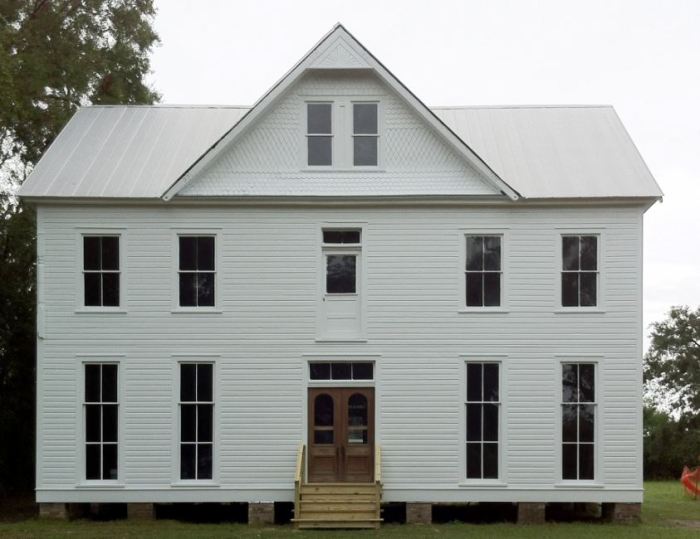
W.J.Quarles House Long Beach Harrison County JRosenberg, MDAH 9-30-2012 from MDAH HRI accessed 4-1-2014. First-floor windows are box-head windows. Note the lower sash is twice the height as the upper sash.
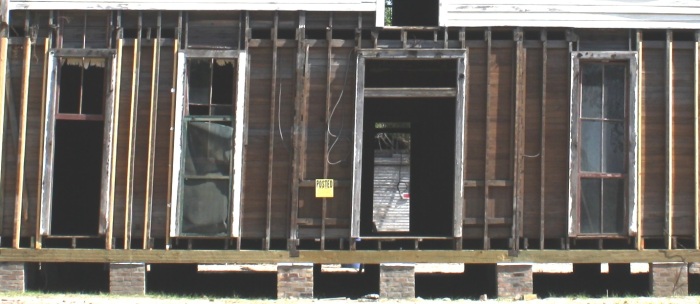
detail W.J.Quarles House Long Beach Harrison County JRosenberg 5-9-2011 from MDAH HRI accessed 4-1-2014. Note the box cavity visible where siding has fallen away.
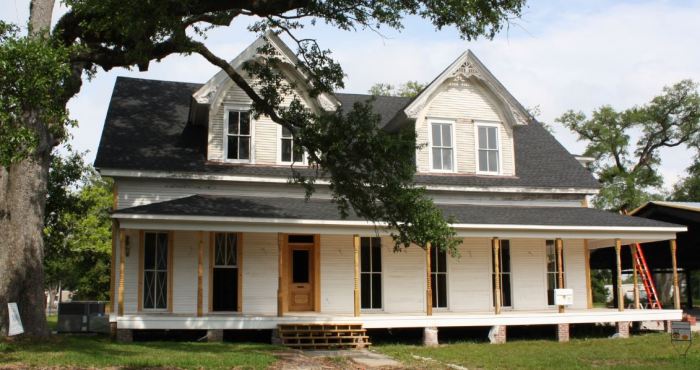
Krebs House Pascagoula, Jackson County. JRosenberg, MDAH 5-6-2009 from MDAH HRI accessed 4-1-2014. Note that both upper and lower sash are equal height. Additionally, note that both sashes are raised in the open window (second from left).
Relating back to the VAF discussion, I was surprised to learn that the design was being implemented into the 1920’s and even into the mid-20th century, but it sounds like as time progressed the window openings typically got smaller. The question originally posed was regarding an 1883 structure with windows that are 3′ x 10 1/2′. The W.J. Quarles House windows are 2’6″ x 9′ 6 1/2″. I don’t have measurements for the Krebs House windows, but I believe the openings are roughly the same size. The examples I found dating from the c.1920 appear to be small double hung or single sash windows where ventilation was the primary concern (i.e. bathrooms).
Two of the above examples come from the 1911 Radford’s Portfolio of Details of Building Construction. In the book, William Radford appears to distinguish between sliphead and a jib windows by noting that a jib window has a single sash and a sliphead window has two sashes that are both capable of sliding up into the wall cavity. Interestingly enough, Radford’s sliphead window details are part of a solid masonry structure. William Radford was also Editor-in-Chief of the magazine American Carpenter and Builder, and his definition of a jib window as a single sash carries over to that publication as seen in the 1912 AC&B example above.
The earliest use I came across of the term ‘Box-head” in relation to a window was in the 1869 Woodward’s National Architect by George E. Woodward. For Design No. 1, Mr. Woodward produced a plan that instructed carpenters to:
“Make the mullion window frame in parlor front, with box-head, and all other frames throughout, (above the cellar,) the usual box frames for double hanging the sash, with 2-inch best pulleys, iron weights and hemp cord.”
My initial thought is that the window type evolved as part of a clever creation of the balloon frame, but Design No.1 is of 8×4 and 6×4 braced timber frame. Both Woodward’s Design No. 1 and the 1875-1876 Beck House in Vicksburg share strong features of the Italianate style. While the houses have enough differences to clearly indicate the Beck House is not based on Woodward Design No. 1, I wonder if those porch windows on the Beck House have a Box-head component? Unfortunately, the rather descriptive National Register Nomination does not fill us in on that detail
Another reader of the VAF post suggested the term “pocket window.” Malvaney and I snickered that anything in a pocket with a hole in the bottom would only fall out, but sure as day Cyril Harris’ dictionary did have the following definition for a pocket-head window:
Pocket-head window:- A window in which a part of the sash slides upward through an opening in the head of the window frame.
A true pocket window might rather refer to the side sliding concept, in the same manner as a Pocket Door. The example of a pocket window can be seen in the c.1877 Scooba, Miss. Laborers cottage George Palliser design.
“The arrangement of the windows is one of the principal features in the design. The lower sashes are arranged to slide into the walls, and the transom sash to swing. In this way the whole of the windows can be opened instead of half, as is usually the case. The rooms are all well supplied with windows, and from their arrangement, if there is a breeze, a good draught will be obtained.”
Since these windows did not open on to a porch, their opening was most certainly not meant for passage. It’s possible that this sliding window is utilized because it requires little or no hardware when hardware may have been a luxury. I’ve seen this type of window in utility areas like garages or in small industrial structures. In these environments hardware simply might not have been necessary or may have been too easily broken.
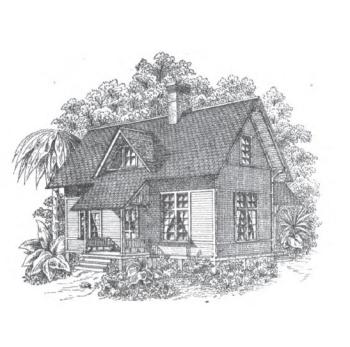
Laborers Cottage on the Estate of J.A. Minniece Esq. Scooba, MS. Palliser, Palliser & Company, Architects. Built c. 1877. Image from the publication “Palliser’s Model Homes” 1883 edition.
So there’s a rundown of some window definitions. Do you know of another term that is used to describe the types of windows seen in this post? Or do you know of a structure with a window that operates in this fashion? If so share it with us and let MissPres know what you see in your neck of Mississippi.
_______________________________________________________________________________________
American Carpenter and Builder Vol XIV No. 3. American Carpenter and Builder Company. Chicago, Ill. December 1912.
Dictionary of Architecture and Construction Cyril M. Harris. Fourth Edition. McGraw-Hill. New York, NY. 2006.
Palliser’s Model Homes. Palliser & Palliser Architects. Bridgeport, CT. 1878
Radford’s Portfolio of Details of Building Construction. William Radford, Bernard L. Johnson, Charles P Rawson. The Radford Architectural Company. Chicago, Ill. 1911
Universal Design Book No. 25 on Builder’s Woodwork. Universal Catalog Bureau Dubuque, Iowa 1927 Page 145
Woodward’s National Architect. George E. Woodward, Edward G. Thompson. Published by George E. Woodward. New York, NY. 1869
Categories: Architectural Research, Books, Gulf Coast, Historic Preservation, Long Beach, Pascagoula, Vicksburg

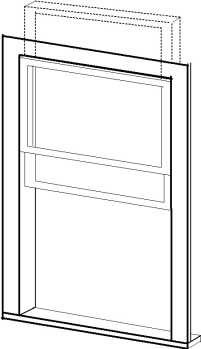




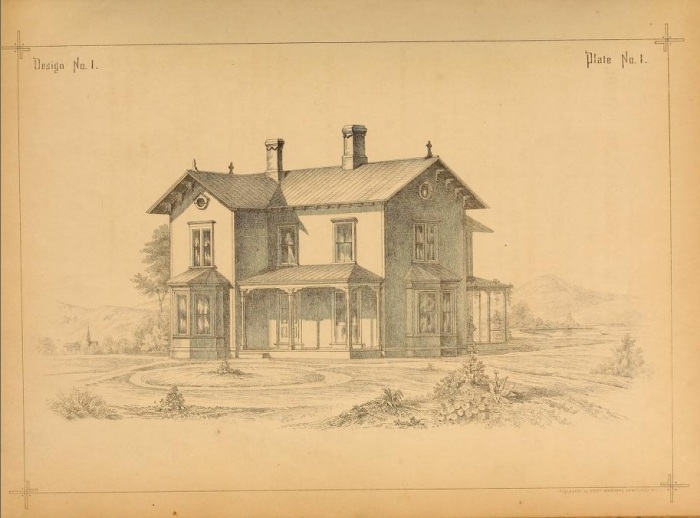
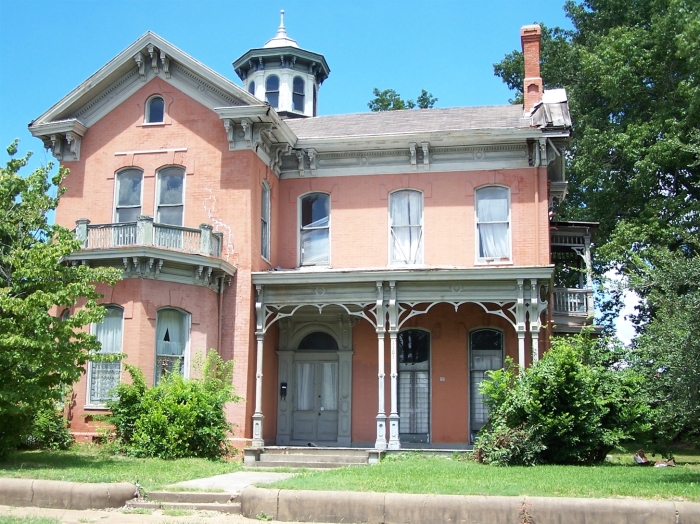
A variant of these designs was one produced by Fred Francis, where the screen rose and fell in and out of the wall when one raised or lowered the sash. As I remember, there were screens “stored” above the window and below the window in his house, which might explain why one account on-line speaks of the screen rising and the other of its falling.. http://penelope.uchicago.edu/Thayer/E/Gazetteer/Places/America/United_States/Illinois/_Texts/DRUOIH/Northern_Illinois/22*.html and http://cityofkewanee.com/FrancisParkBrochure.pdf Also,the winindow system is mentioned at 7:00 at the following video http://www.youtube.com/watch?v=2WeOrh1gYcU,
LikeLike
Thank you for the comment and links! Yes screens did sometimes appear with the window type during the 20th century. I’m not familiar with one in Mississippi but that does not mean they arenot out there. Longwood in Natchez does have a sliding pocket screen but that was a 20th century addition to the house that does not follow Samuel Sloan’s design.
LikeLike
Thanks are due you for all the work this posting represents! I hope that you might enjoy Francis and his Woodland Palace.. His house gibes us a view of how a 19th century person, without electricity,might solve various “modern” problems in home building, heating, ventilating, etc. Survivalists take note! .
LikeLike
We’re renovating a ca. 1960 house in Alaska, and it has these windows whose upper sash slides up into the wall. I’d love to keep them, but it’s just too cold here to have an uninsulated pocket above the windows. But it was surprising to find such old-fashioned windows in such a relatively new house. Also has wooden storm windows, hinged at the top.
LikeLike
Very cool. ( no pun intended) Your are right that is surprising to see a window of this style made that late. It sounds like that pocket would be a good place for insulation. Pair your refurbished existing storm window and sash with an interior storm window and you might be able keep the originals while having the same energy efficiency of a new window. Maybe even for less cost than a new window?
LikeLike
I could turn it into a fixed window, and insulate above. We seldom need to open windows for cooling; very rarely reaches seventy degrees. So heat retention is the primary consideration.
I’m guessing these windows were ordered from a Seattle supplier, or possibly from Sears; havent researched the catalogs. Regardless, worth saving as a quaint anachronism. Or maybe they were common here at that time; more research needed.
LikeLike
The Rrosenthall Group INC USA is remodeling The Beck House in Vicksburg, Mississippi and desire to work with your Windows.
Thanks
Robert Rrosenthall own
LikeLike
How wonderful is this site. Years ago my Victorian home had two of these windows in the dining room that went to the side porch. I argued with the previous owners and said it doesn’t make sense that this large bottom sash with only open up 3 feet. One day I noticed that the stained wood piece at the top of the window sash appear doubled up. It didn’t match any of the other windows in the house. I unscrewed it and low and behold there was the opening for the sash to slide right up into. I took both off pulled out the insulation that have been stuffed up there and open the window right up like it had been years ago. Interestingly enough curators at museums have never been able to answer me as to what this window was called. One day a lady called it a jib window. Several curators later told me that this is not correct. I was determined to find out what this is called and did a lot of searching online. And ‘poof” I find this website and forwarded it to all of the curators that I’d spoken to. So now everybody can be learned LOL
LikeLiked by 2 people
Thank you for the complement on the site. I am glad you found the information useful and are paying that forward.
LikeLike
If memory serves, Mount Holly (on Lake Washington-now destroyed by fire) had these windows and wonderful large interior shutters that folded flush to the jambs providing the ability to walk through the windows. I only stayed there a couple of times way back when (in the 1970s). It was a grand house.
LikeLiked by 1 person
The mechanics of how that box head window worked with the masonry walls would have been interesting to see.
LikeLike
Thank you for sharing this information! We are restoring an 1890 Queen Anne in Atlanta and just discovered we have two windows (one in the front parlor and the other on the wraparound porch) that the lower sash slid up into the wall. They were removed and replaced with doors, but we found one of the original window jambs along with the sash pulleys. We didn’t know what to call them but now I believe they are box-head windows. I’m curious to learn more about how they built these and will take a look at your sources.
LikeLiked by 1 person
The Phoenix, AZ Rosson House Museum built in 1895 has these opening window/doors.
LikeLike